For much of my life, my creative space has been an appendage, an after-thought, a space co-opted from existing living space. You know what I mean. There was the craft room in a converted basement, the closet that doubled as a dark room, and of course a series of guest bedrooms too full of fabric to ever host guests.
Then, for twelve years, my studio was a yurt, a 28-foot round, insulated tent. It was a wonderful work space with lots of light provided by a big central skylight and vinyl windows. The space was heated with a wood stove that my husband Tom, lovingly stoked for me on cold mornings—after he saw my ax-wielding kindling-cutting skills [More like do-it-yourself amputation skills. —Tom].
Three years ago it was time to say goodbye to the yurt and build a new and improved studio. Better storage was needed (corners give extra space), and straight walls would give me the ability to have a nice pinning wall. I put a lot of thought into the various design elements and Tom put much of his time and effort into its construction. I love my studio. It’s not over the top, but it has the elements that I need. Here are what I identified as necessary to this creative space:
- fabric storage
- sewing machine table
- adjustable piecing board
- pinning wall
- work table
- other storage
- desk for computer and paperwork
- good lighting
Here’s my floor plan. It’s mainly an open 28 x 32 foot box out of which I have carved space for each of those elements.
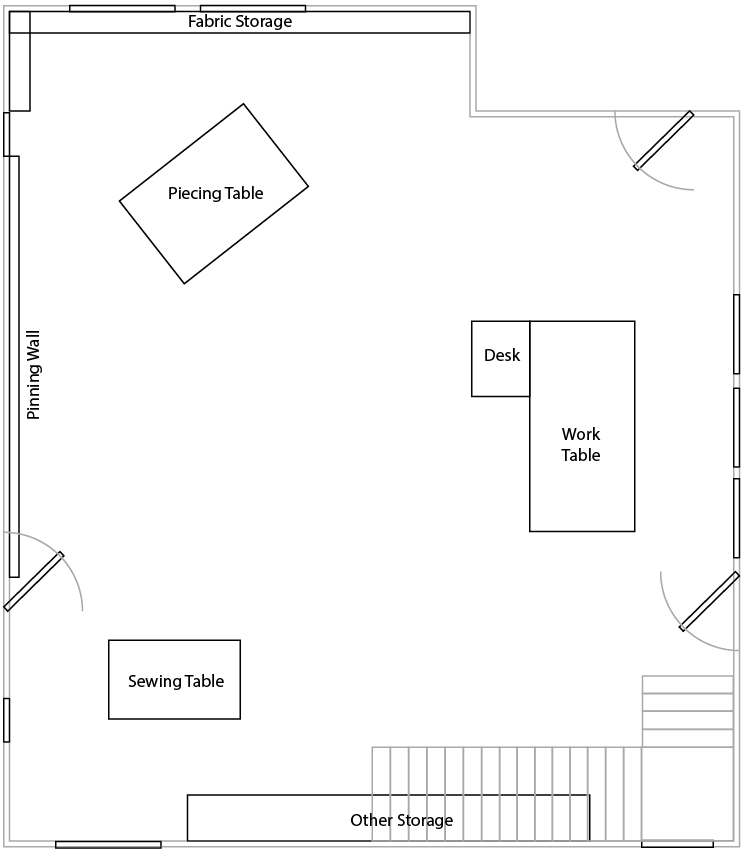
These are the most crucial items, for my way of working. It may look like there’s lots of open space, but trust me, it’s used. I’m definitely a pack rat. There are chairs, and little tables, and bookshelves, and . . .
And there are details the floor plan doesn’t show. Most of them don’t even show up at first glance. It’s the details that I think make a creative space more than just an open box with tables and shelves.
Light
Let’s start with light. It’s about as fundamental a need as there is. Light during the day and light at night. So that means windows and artificial light.
Non-artists might think, well, let’s put as many windows as possible in the south wall. That’s where the light comes from. If I was making a passive solar house, that’d be a good idea. For most artists, direct light isn’t so helpful. It’s inconsistent in its direction and intensity. It also fades fabric. Since indirect light also fades fabric eventually, my windows are low-e, which blocks at least some of the harmful UV rays.
When I’m constructing a quilt, northerly light is nice as it’s a consistent light without the strong sun and shade as the sun moves through its cycle. That’s why I have two big windows on the north wall near my piecing table.
Direct light is useful for other jobs however. Three tall east-facing windows spill light onto my work table, where I might be framing or cutting or doing paperwork. A single south-facing window floods light onto the sewing table, where seeing the stitches as I free-motion quilt is critical.
Meanwhile the western wall contains only two small windows. This allows room for a pinning wall (see below) and keeps the late afternoon light from making distracting shadows on my piecing table. However, we installed three sun-tubes from the roof to bring natural but indirect light into the area of the western wall.
At night I have two banks of daylight-bulb fluorescent spotlights running parallel to the east and west walls. I know there are other lighting solutions, and I may do more research and vary this later, but it works for now.
Pinning Wall
The largest pinning wall I ever had before this was a 4 x 6 sheet of plywood covered in black felt. When designing this new studio, I decided to devote most of the west wall to that purpose. As described above, that made the most sense light-wise.
I wound up having fourteen feet to devote to the pinning wall. It was designed to be replaceable when and if needed. (Like when Djinni cat sharpens her claws on it one too many times.) We used 2-inch thick sheets of 4 x 8 foot styrofoam insulation. Luckily, I found a more neutral blue instead of pink or foil covered sheets. Rather than screwing them directly to the wall, they are affixed to strapping, leaving a 3/4 inch space for air circulation. Tom was warned that styrofoam attached to the wall could actually trap moisture.
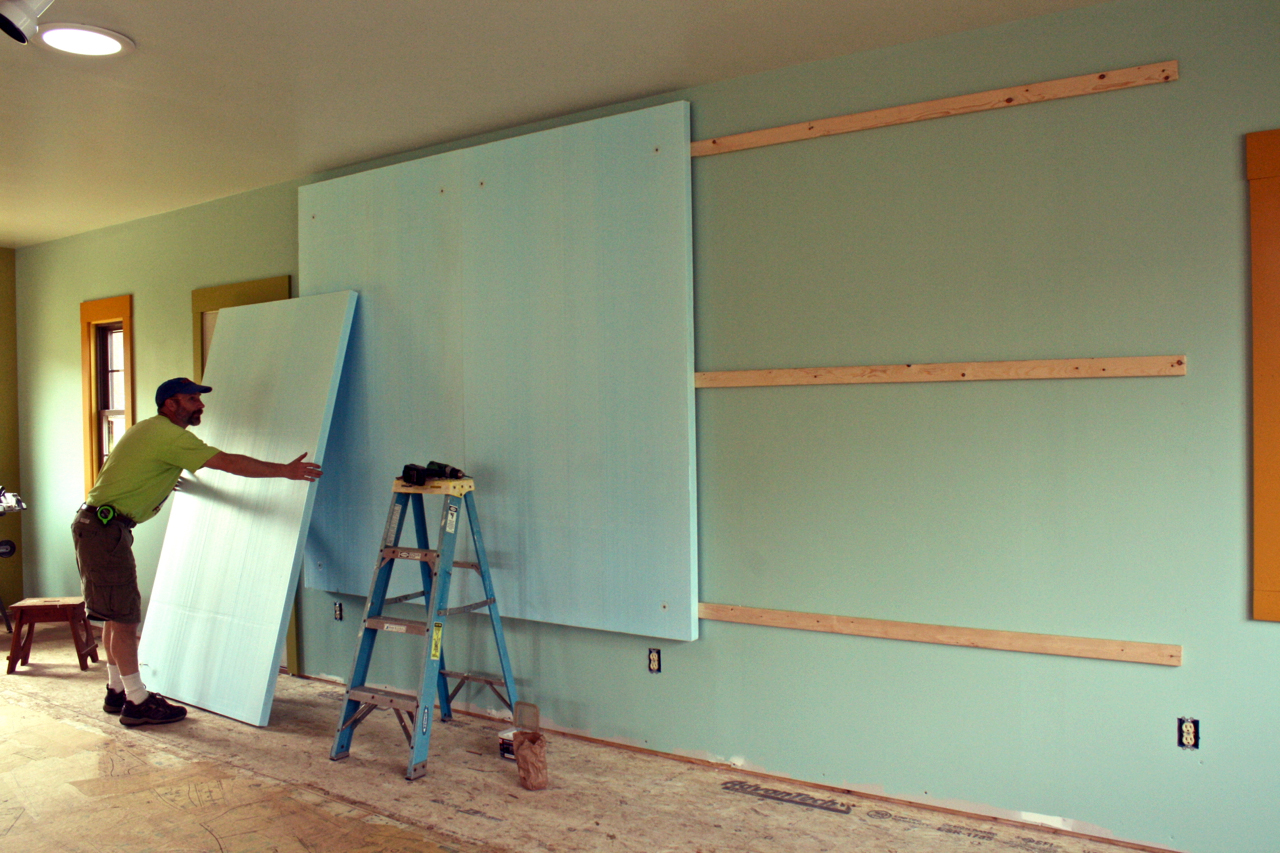
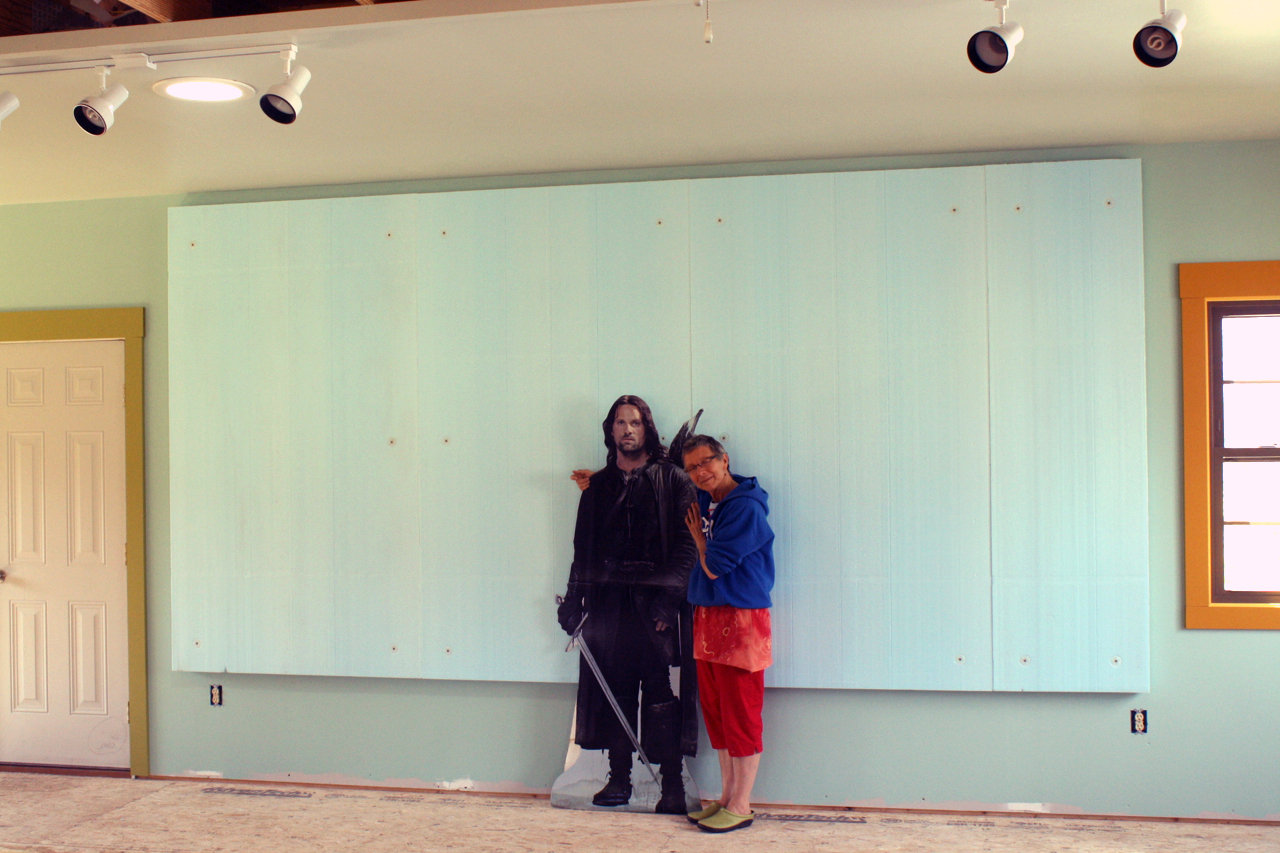
At one point, I questioned whether fourteen feet was excessive. So of course, one of the first quilts I made in this new studio was “Crocodylus Smylus,” a life-sized 20-foot salt water croc, necessitating extensions at each end of the wall.
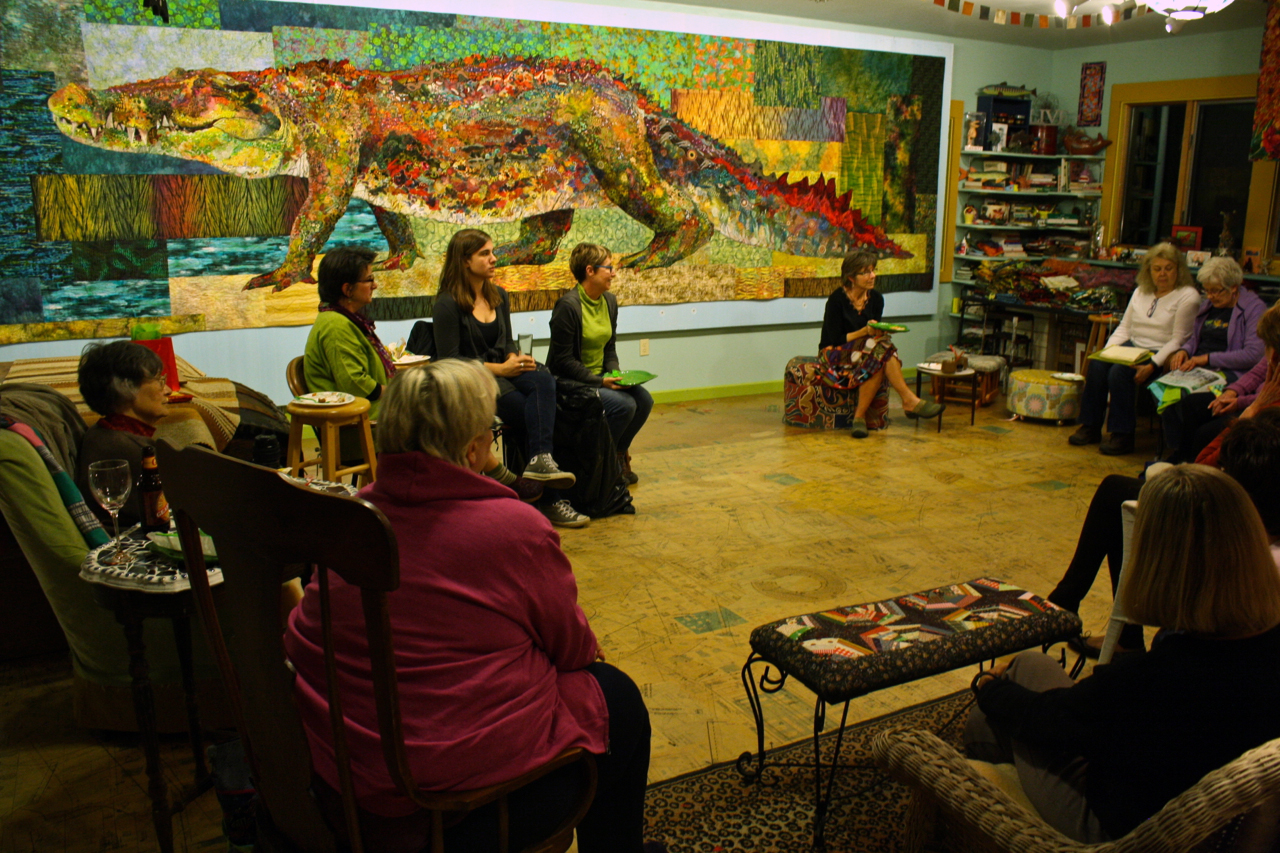
Piecing Table
Since every other quilt I’ve made has never come close to fourteen feet, I usually start, and sometimes end, their collage construction on my piecing table. This converted drafting table allows me to angle the surface so my fabric doesn’t fall off as I audition it. Plus I have the option to sit while I work.
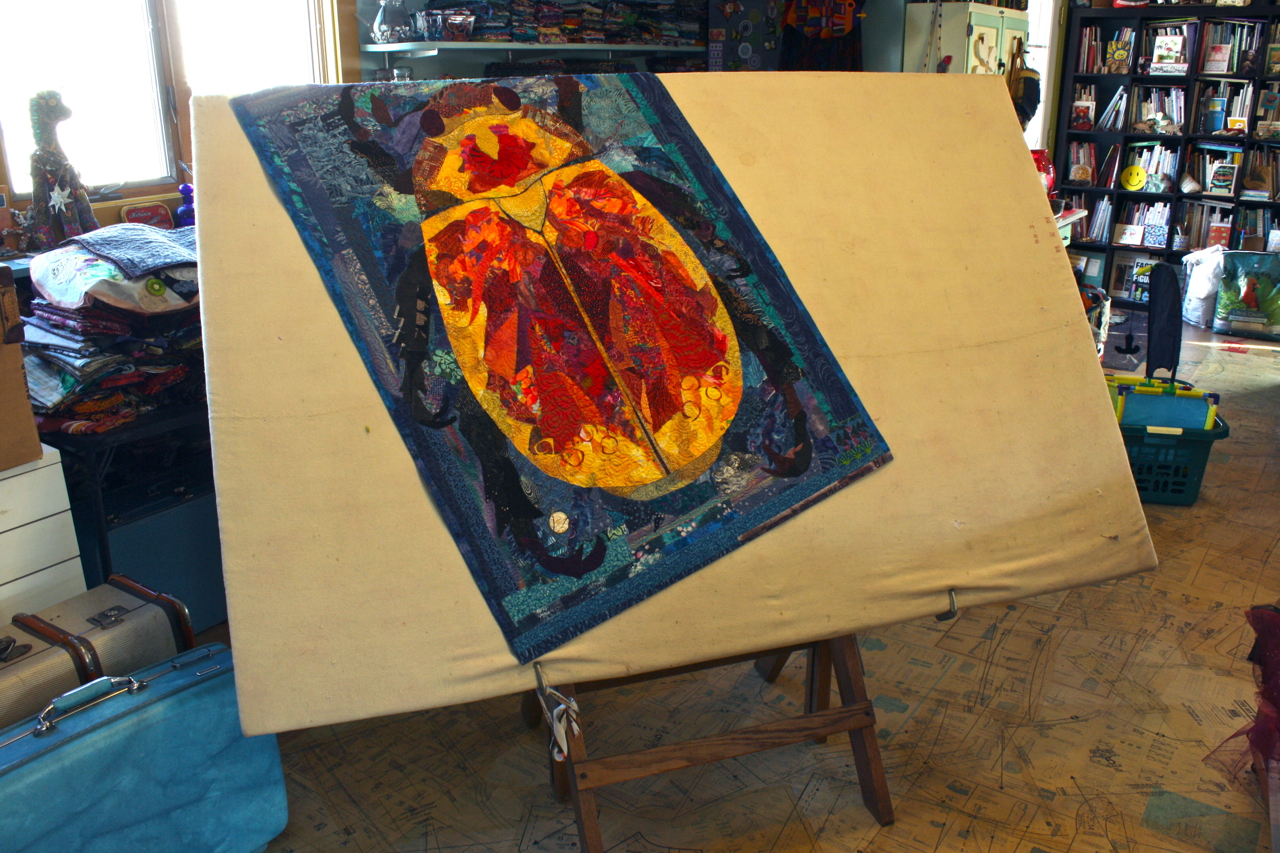
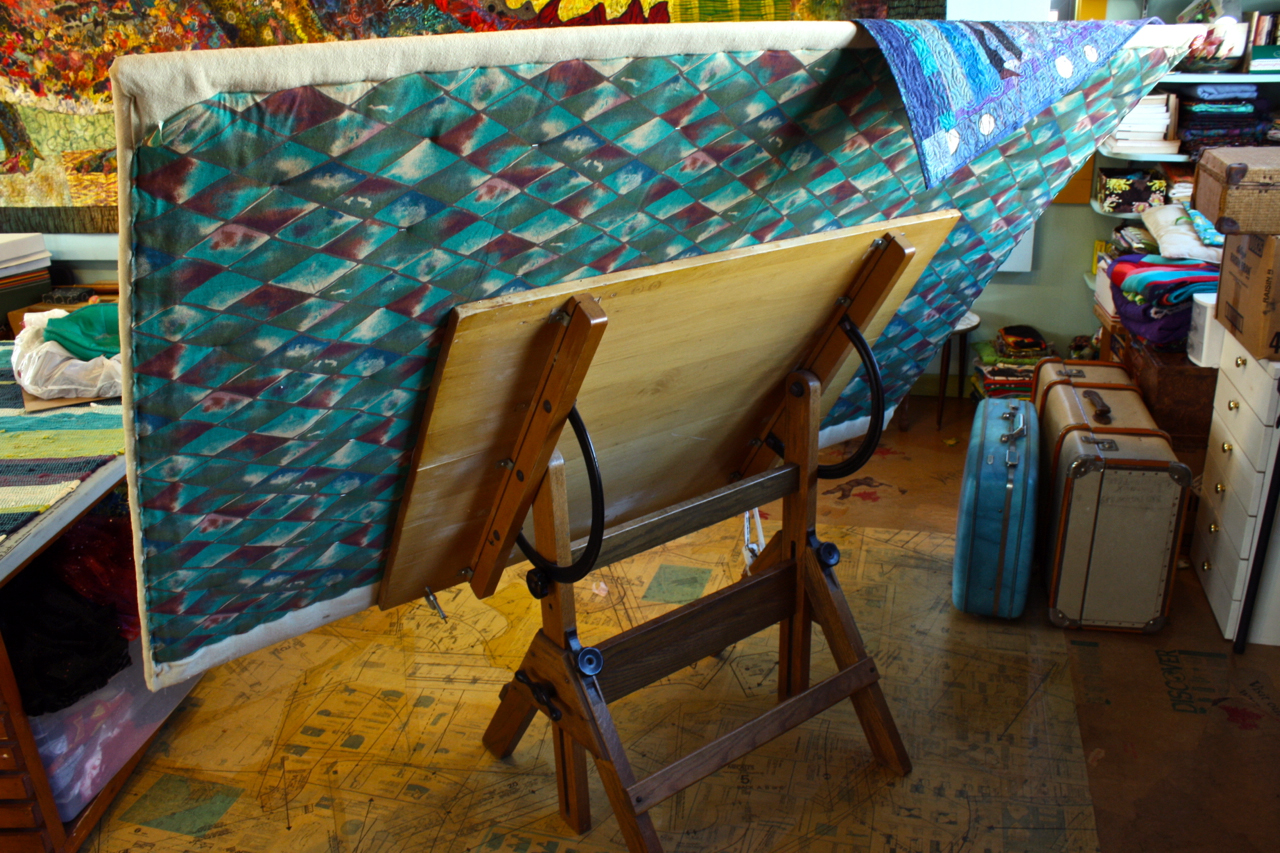
I adapted the drafting board by clamping a 6′ x 4′ homasote board to it. The homasote (found at a lumber yard) provides a permeable surface, which I have covered with felt, allowing me to pin into it. Clamps let me to remove the board when necessary.
Sewing Machine Table
My sewing machine sits inside a rugged oak trestle table my dad converted. He cut a hole in the top of the table then constructed a box under the table to hold the machine.
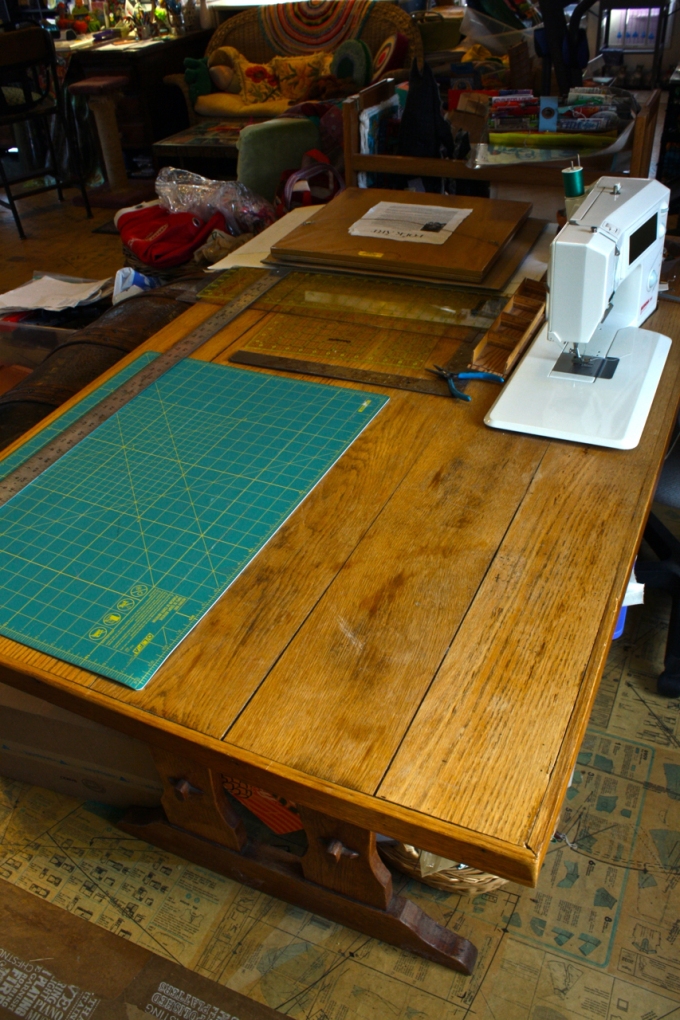
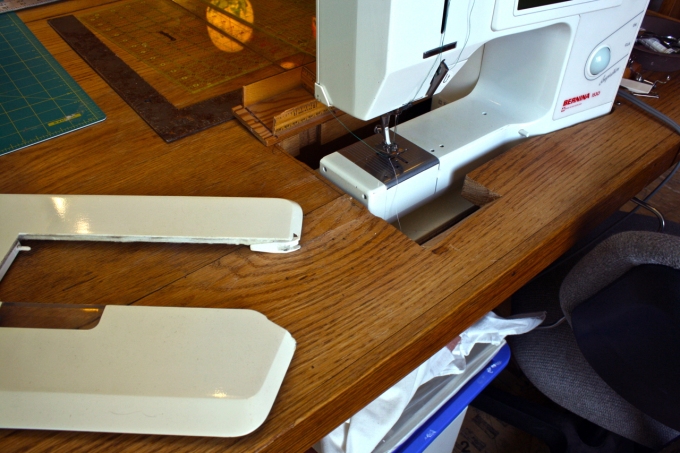
There are fancy-schmancy sewing machine tables with doodads and doohickeys all over, but I like the look and feel of this table. It’s sturdy and simple.
Work Table
I can never have too much storage. I’ll pack every nook and cranny full of stuff. Just ask my husband.

So I was thrilled to acquire my work table. Made in two sections, each is a 4 x 4 foot cube. I got them when a big-box fabric store was going out of business. As you can see, they are open with shelves inside providing ample storage for little-used or especially heavy items.

Desk
I don’t really need a desk, per se. I could make do with some filing cabinets and some shoeboxes if I had to. But when my parents moved and they didn’t have room for my dad’s old desk, I had to give it a home.
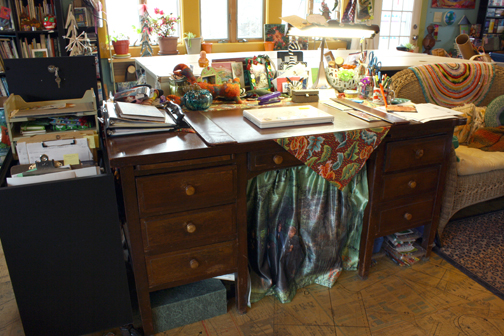
This is the desk my dad had when I was growing up. There is also a wooden swivel chair with white leather padding and big brass upholstery tacks. Not a valuable antique, probably not as useful as a modern computer desk, but special to me.
Floor
My studio was supposed to have a painted tongue and groove wood floor. Thank heavens that didn’t work out. Instead, inspiration struck and I collaged the floor with some of the hundreds of dressmaking patterns I had rescued from being taken to the dump years before at the end of a yard sale. Just knew they’d be handy sometime (see why I need extra storage?).
Using a water and white glue mixture, I (and Tom) soaked the instructions and laid them down. After the floor was covered I added the tissue-paper patterns directly on top so the instructions show through.
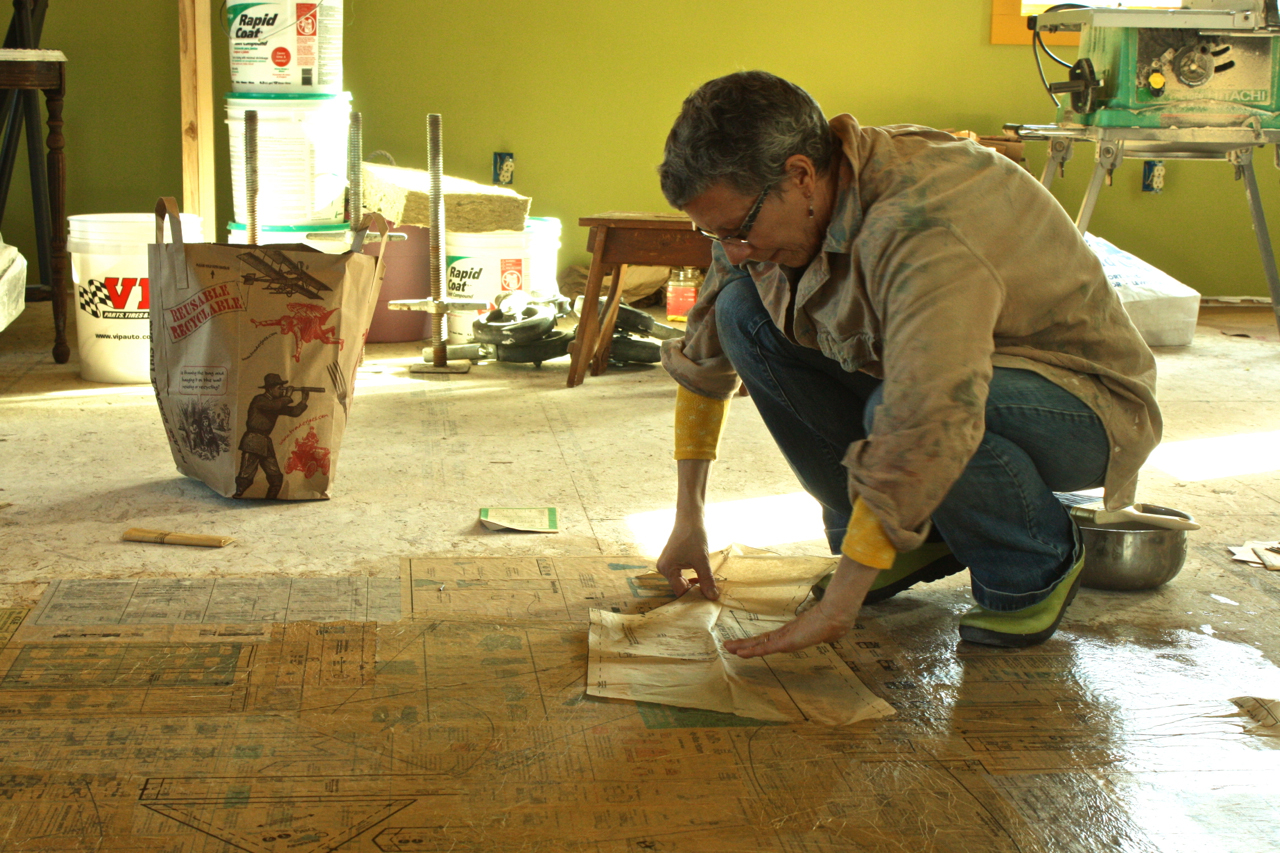
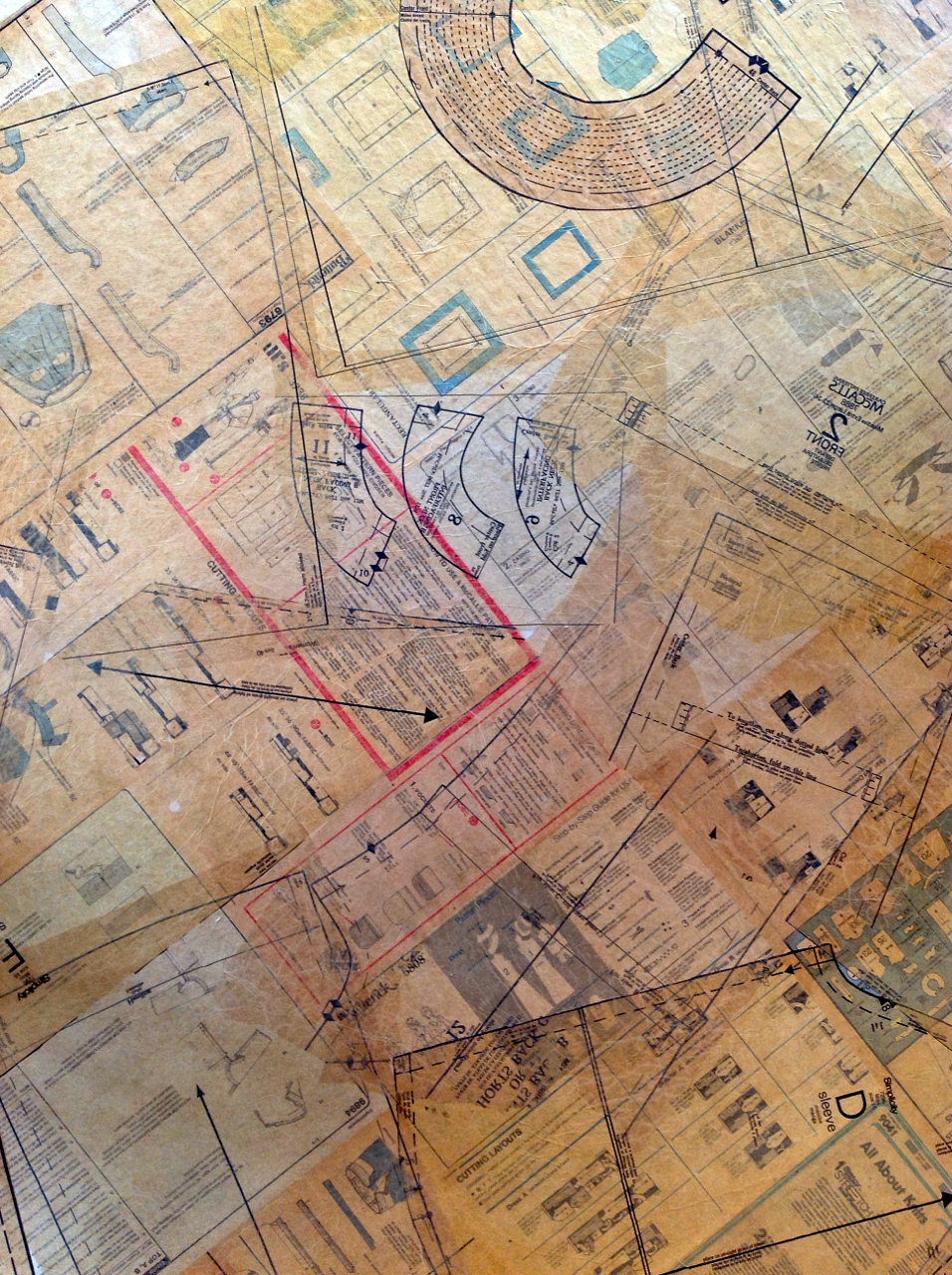
After the floor was covered, I sealed it all with a few coats of polyurethane.
It’s in the Details
So those are just some of the things that I especially appreciate about my studio. Those and the seven different colors of paint I chose to use on the walls, window frames, and ceiling. Let me tell you, Tom loved that idea.
When I’m off on my teaching adventures I meet lovely people and truly enjoy the camaraderie of the quilting world. It’s a creative vocation that I’m quite grateful for. But the time I spend being creative for others needs to be balanced by the time I spend being creative for myself in my studio.
It’s not the most extravagant or well organized space, but when I walk into it in the morning, or return to it after travels, I feel good, even nurtured. I pause, pick up my cat, and we both start to purr.
What do you like about your studio or creative space? What don’t you like? How does your space affect your creativity? Be sure to share your thoughts in the comments.

Susan,
I love seeing your studio! However, the links in the email version of your post didn’t work. All had error messages.
Ellen Lindner
Fabric collage website: http://www.adventurequilter.com
Art and creativity blog: http://adventurequilter.com/blog/
I love your studio. You refer to a link to your newsletter regarding how you did your studio floor but there was no link. I would love to have that information. My studio floor is just sealed plywood. I love your floor.
Thank you
Donna Taylor On Beautiful Whidbey Island, WA
>
Sorry for the confusion. I pressed the wrong button and posted before I was ready. The blog complete with links will come out tonight.
Sorry for the confusion. I pressed the wrong button and posted before I was ready. The blog complete with links will come out tonight.
Beautiful studio! Very creative too…like it’s owner. 🙂
It is even better now that you are fully moved in!!Thanks for sharing!
Love that floor! And the piecing table…I am outright, openly coveting that!!! What a great idea, tilting it for a different view or to sit! You are so clever!
I also love your space, especially the gigantic pinning wall! Let’s see…my space is on the second floor of our attached barn so the commute is dry though chilly in winter. I share a similar history to your basement, bedroom, etc story. I used the dining room until the chaos made my husband cringe too openly. I have lots of open shelves which is great to see fabrics but the mice tend to cuddle in the folds so now I have clear plastic boxes and jars. I love the barn smell, the view of my garden in summer, the chaotic harmony, and the fact that I can be wildly creative and then walk out and close the door and make dinner and not have to clean everything up! I have a quilt frame and machine I purchased from some friends of yours…I walked into their home and there was your quilt of the sun and the moon hanging on the wall! I love this creative technique and adore the freedom! Thank you for introducing me to this way of painting with fabric.